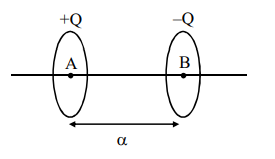Question:
The two thin coaxial rings, each of radius ' $a$ ' and having charges $+Q$ and $-Q$ respectively are separated by a distance of 's'. The potential difference between the centres of the two rings is :
Correct Option: , 4
Solution:

$V_{A}=\frac{K Q}{a}-\frac{K Q}{\sqrt{a^{2}+s^{2}}}$
$V_{B}=\frac{-K Q}{a}+\frac{K Q}{\sqrt{a^{2}+s^{2}}}$
$\mathrm{V}_{\mathrm{A}}-\mathrm{V}_{\mathrm{B}}=\frac{2 \mathrm{KQ}}{\mathrm{a}}-\frac{2 \mathrm{KQ}}{\sqrt{\mathrm{a}^{2}+\mathrm{s}^{2}}}$
$=\frac{Q}{2 \pi \varepsilon_{0}}\left(\frac{1}{a}-\frac{1}{s^{2}+a^{2}}\right)$
Ans 4
Click here to get exam-ready with eSaral
For making your preparation journey smoother of JEE, NEET and Class 8 to 10, grab our app now.
